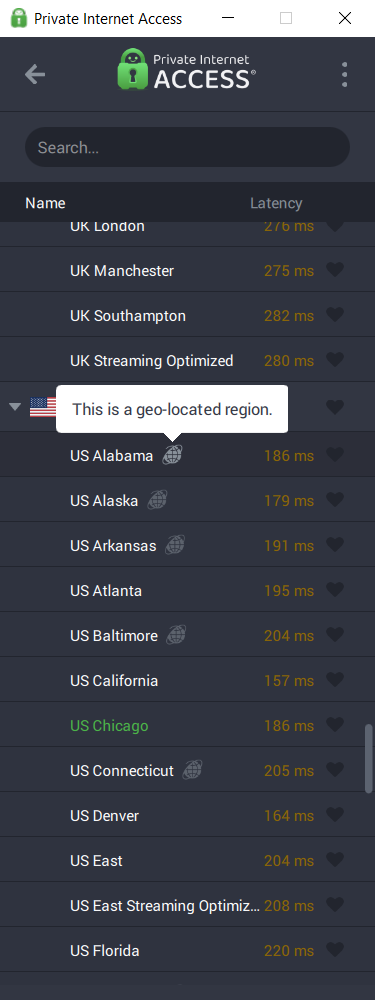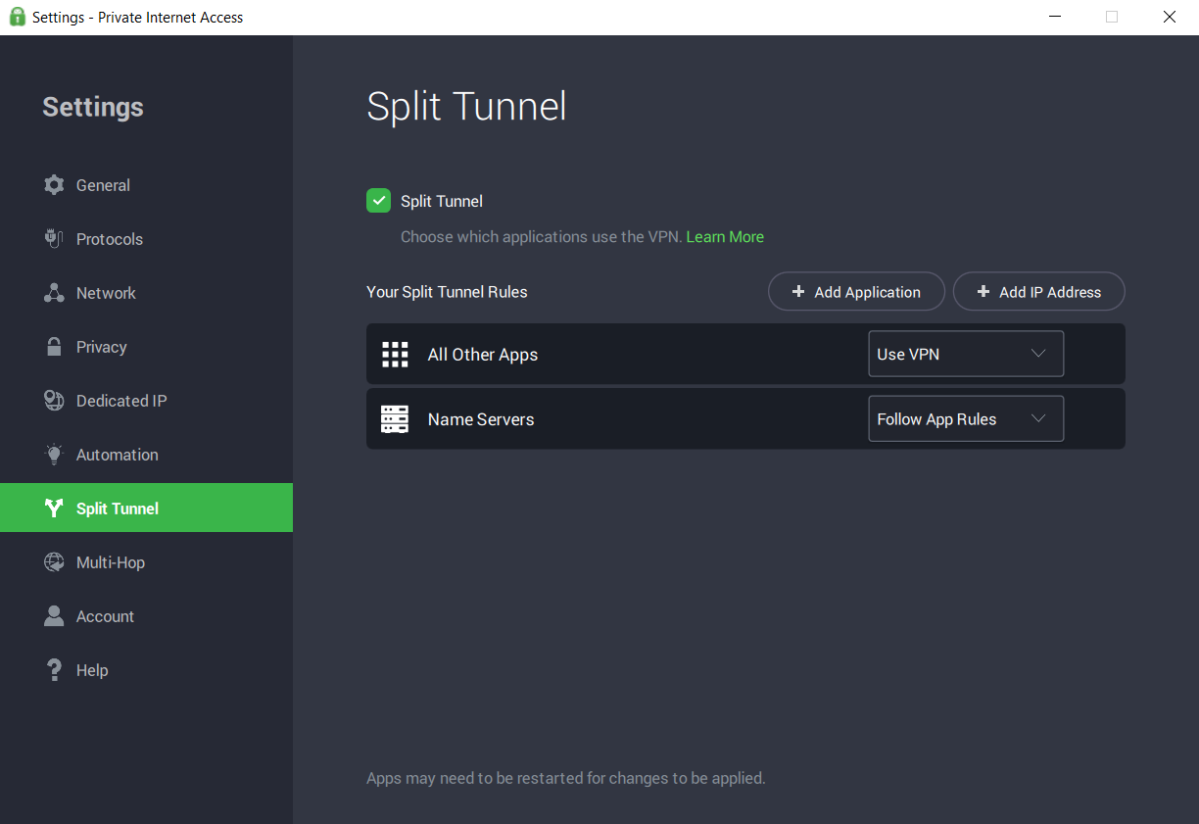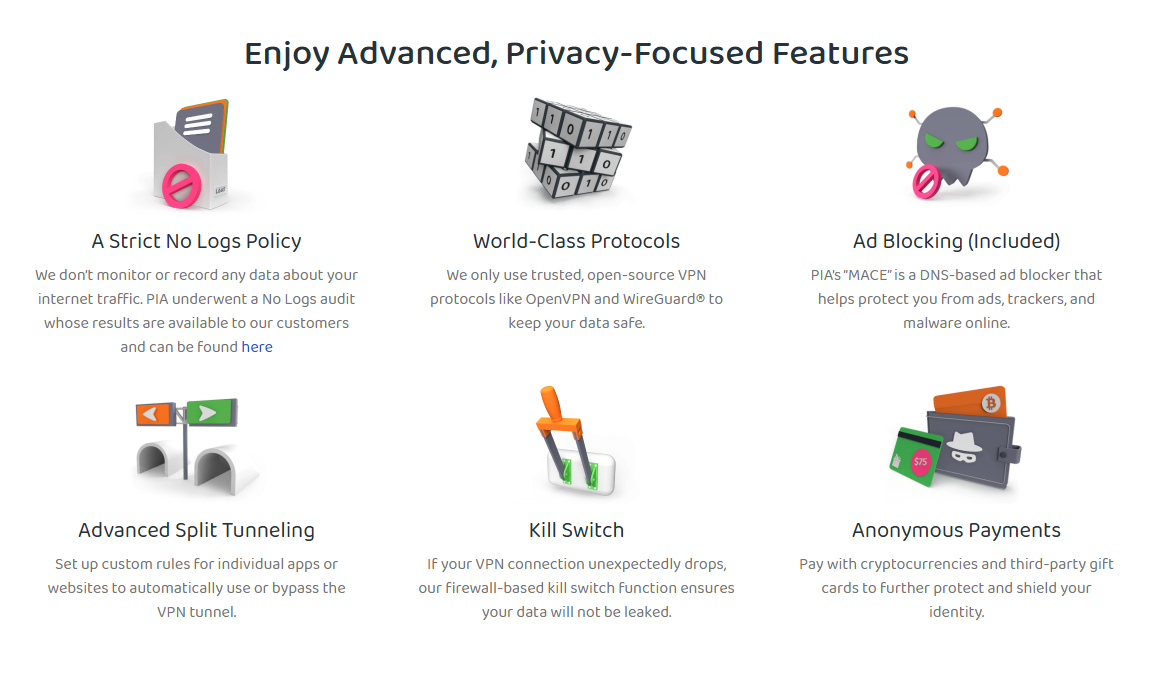
At a Glance
Expert’s Rating
Pros
- Multiple independent no-log audits
- Unlimited simultaneous device connections
- Massive server network
- Low-cost subscription plans
Cons
- App is a little clunky
- Speeds are underwhelming
Our Verdict
Private Internet Access continues to be one of the top VPN services on the market. It’s affordable, offers plenty of servers, unlimited simultaneous device connections, and has proven strong privacy credentials thanks to multiple independent audits. It might not win any speed races, but it’s hard to argue with the value it provides.
Price When Reviewed
This value will show the geolocated pricing text for product undefined
Best Pricing Today
Best Prices Today: Private Internet Access
Private Internet Access (Monthly)
$2.19
Private Internet Access (PIA) has seemingly been around since the advent of third-party VPNs. Since that time, it’s been a favorite VPN service for many users thanks to its excellent pricing and good privacy guarantees. Recently the service has made some truly promising improvements by lifting the device connection limit and undergoing a third-party audit. So, with these new updates, how does PIA stack up against the other titans of the VPN market?
Read on to learn more, then see our roundup of the best VPN services for comparison.
Private Internet Access VPN in brief:
- P2P allowed: Yes
- Simultaneous device connections: Unlimited
- Business location: U.S.
- Number of servers: 35,000+
- Number of country locations: 91
- Cost: $11.95 per month, $39.95 for one year plan, or $79 for a three year plan
What are Private Internet Access’s features and services?
What’s new with Private Internet Access?
Since my last review, PIA has mostly focused on systematic improvements. It has expanded its server network to include 10 new locations in Europe, plus it has added servers in all 50 U.S. states—although some of them appear to be virtual.
Additionally, the service has redesigned its Android app, completely rewriting it in Kotlin. As a result, the app now features more extensive user customization options and added the ability to connect to a Shadowsocks obfuscated server directly from the app itself.
Private Internet Access hands-on

PIA’s homescreen defaults to a minimized window that can be expanded to show more information or servers.
Sam Singleton
Upon first opening PIA you’re presented with a simple panel in the lower-right corner of your screen. By default this panel is anchored to that location unless you unlock it in the settings menu. It’s an interesting design decision and one that breaks the mold of nearly every other windowed VPN app out there. It feels a bit constrained, but then again maybe I’m just used to having a free-floating window by default.
The Windows app itself is pretty straightforward. There’s a big on/off button at the top, and below that is the VPN server location—clicking it expands the screen to view and choose a different country or server location. For countries with multiple location options you’re able to click a drop-down menu to display all of the available server locations within that country. And boy, are there a lot to choose from. PIA offers servers across 91 countries and, while not officially confirmed, it’s believed to have a staggering 35,000+ servers.

PIA’s extensive server list provides useful information including latency and physical/virtual server locations.
Sam Singleton
Next to each country location is its latency displayed in milliseconds and there’s a heart icon which allows you to designate a server as one of your favorites. It also conveniently denotes which servers are virtual servers with an icon that states “This is a geo-located region” next to the name.
A virtual server is not located within the country itself, but rather assigns an IP address of the country location instead. The transparency here should be commended as not many other VPN providers willingly label which of its servers are virtual or physical.
Overall the server list layout effect is nice and simple to follow. PIA allows you to sort its server list either by latency or location name as well. This makes it much easier for people who are only interested in speed to find the optimal connection, or likewise, by name, to find their desired location.
Once connected, the app displays your actual IP address and the VPN address you’re using. This basic information is all you can see in the compact view, but if you click the downward-facing arrow at the bottom you can see a ton of extra details as well.
PIA’s publication of transparency reports and up-front nature regarding user privacy and security should be commended.
This includes quick-connect options with locations such as France, Germany, the U.S., and the UK. There are also tiles for bandwidth usage, a performance graph, data encryption and handshake settings being used, and basic settings control. If you prefer to see any of this information on the compact view instead, you’re able to click the bookmark icon on any tile to display it. You can add or remove any of these options as you see fit.
While I appreciate the extra connection details menu, when expanding the drop-down menu it shot past the bottom of my screen, making it awkward to view all of the data or even find how to reshrink the menu back down. It’s a small gripe, I know, but an (overdue) interface update could easily remedy these clunky app display issues.

PIA has a robust feature set, which includes a highly customizable split-tunneling feature.
Sam Singleton
Private Internet Access comes with a plethora of great features such as split tunneling, multi-hop, and a kill switch. It even allows you to designate an app-based kill switch, which will block traffic only on specific apps should the VPN connection break.
It’s worth talking a little bit about PIA’s split-tunneling feature. Split tunneling allows you to pick and choose which apps you wish to run through a VPN, allowing you to optimize bandwidth for low-risk activities such as streaming or gaming. And PIA has one of the most dynamic split-tunneling features I’ve ever seen. Power users can go to town tweaking things such as which apps, IP addresses, and DNS requests are allowed to bypass the VPN.
Additionally, taking after other VPN providers such as NordVPN and Surfshark, PIA has added a handy security extra in the form of an ad- and tracker-blocker it calls MACE, and data-breach monitoring with its Identity Guard feature. This is something that’s becoming more common as a means to entice users with a complete online security suite rather than just a VPN service. You can even opt-in to an antivirus tool from PIA for an additional fee when you sign up if you so choose.
The convenience of this all-in-one approach is enticing, but generally speaking a standalone antivirus software, like our favorite antivirus suites, will offer you more comprehensive coverage and overall security.
PIA offers a lot of great configurable features and settings, making it a power user’s dream. Some may argue that it lags behind since its main competitors have started offering shiny new features and add-ons—something PIA has so far passed up. But I would argue that what PIA lacks in feature quantity, it more than makes up for in feature quality.
The sheer amount of customization options and ways to tweak connection settings is mind-boggling. For the right user, this makes PIA a better choice overall. Plus, unlike other competitors who may have lost the plot with their desire to innovate, PIA has never strayed from the VPN-first mentality and that should be commended.
PIA is available for all major platforms including Windows, macOS, iOS, Android, Linux, Chrome browser, and some gaming devices and smart TVs.
How much does Private Internet Access VPN cost?
Private Internet Access has long been one of the most affordable premium VPN services on the market. That still remains that case. Some other services can even be found cheaper, but usually with less features.
PIA offers three plans including a monthly plan, 1-year plan, and 3-year plan. The monthly rate is $11.95, which is above the industry average, but cheaper than other top services with similar feature sets.
The 1-year plan will set you back $39.95 or $3.33 per month. If you opt for the 3-year plan PIA throws in an extra three months for free and it will cost a total of $79 or $2.03 per month.
A unique, and economical pricing feature of PIA’s long-term plans is that they don’t drastically increase in price after the renewal period. So if you opt for the 1-year plan, after the first year you’ll only be charged a moderate increase to $49.99 for any subsequent years.
Most VPN providers will offer you an enticing long-term plan deal initially and then after the renewal period, your price will skyrocket up to a much less affordable amount for as long as you continue subscribing.
When you sign up for PIA, it only asks for your email address. It accepts a good range of payment options including credit card, PayPal, Amazon Pay, and cryptocurrencies such as Bitcoin, Ethereum, and Litecoin—there’s also an option to use Bitpay instead of direct wallet transfers.
How is Private Internet Access’s performance?
In my testing, I measured connection speeds across PIA’s servers in different countries all around the world for multiple days and then compared them to my baseline internet speed. PIA’s speeds were alright, but they weren’t enough to make our top five fastest VPNs. Across all locations tested, the speeds averaged 50 percent of the base download speed and a more respectable 77 percent of the base upload speed.
Of course, as one would expect, I noted that locations closer to my physical location had better speed averages, while server locations further away were slower. Latency scores overall were relatively good, comparing similarly to even the fastest services I’ve tested. This means that PIA should be suitable for gaming for most people. I was able to play online FPS games while connected to a PIA server and had no noticeable lag or connection issues.
For a top VPN, I have to admit that these overall connection speed averages are a bit disappointing though. NordVPN, one of PIA’s top competitors, has average speeds of over 75 percent of the base download speed—a full 25 percent faster. Users who demand ultra-fast connections while streaming 4K video or downloading large files may want to consider other options.
At the end of the day, PIA’s speeds aren’t terrible and they should be plenty fast enough to allow you to stream or browse to your heart’s content without noticeable lag—depending on your own home internet connection of course.
When it comes to streaming, PIA successfully accessed all of the major streaming services such as Netflix, Disney Plus, Amazon Prime, and Hulu. I didn’t come across any servers that were blocked and geo-restriction access was never an issue no matter which country’s server I was connected to.
How is Private Internet Access’s security and privacy?

PIA continues to prove that it takes user privacy seriously with a strong privacy toolset.
Private Internet Access
PIA has been owned and operated by Kape Technologies, a UK-based company formerly known as Crossrider, since 2019. There have been some questions in the past about the somewhat dubious practices surrounding Crossrider. Its development platform for browser extensions was used by independent developers to deliver malicious adware and malware to users. Realizing this and facing backlash, Crossrider closed the platform in 2016 and rebranded themselves as Kape Technologies.
Since this reset, and subsequent leadership reorganization, Kape Technologies has pivoted to become a major provider of digital security software. It has gone on a run in recent years of purchasing ownership over some of the largest VPNs on the market today including PIA, ExpressVPN, ZenMate VPN, and CyberGhost VPN, as well as Mac antivirus firm Intego.
To its credit, PIA has taken steps to ease the minds of privacy-focused users with regular quarterly transparency reports. Additionally, in 2022 and again most recently in 2024 the service underwent independent security audits by Deloitte to review its “no-logs” policy. In both instances Deloitte confirmed that PIA stores no logs and no details that could be used to identify users or their activities.
Privacy is the main pillar of a good VPN service and these independent audits combined with PIA’s continued willingness to strive for transparency has done a lot to rectify any concerns over its parent company’s past.

PIA offers a plethora of configuration options for both OpenVPN and WireGuard protocols.
Sam Singleton
PIA uses the industry standard AES-256 encryption and both the Windows and Android apps support WireGuard and OpenVPN protocols. There is also built-in protection against DNS leaks which, when tested using a DNS Leak test tool, proved my real IP was always hidden while connected to PIA’s servers.
PIA also uses diskless RAM-only servers, which boot on a read-only image and use RAM modules instead of hard disks. By not storing data on hard disks, RAM-only servers are more resistant to tampering both by hackers and physical breaches. Data on RAM-only servers is also wiped with each server restart, meaning that any collected user data is usually never stored for very long. While RAM-only servers have become more commonplace among VPN providers recently, PIA was well ahead of the game by installing them years ago.
Private Internet Access is based out of Denver, Colorado in the U.S. This unfortunately means that it could be subjected to mandatory data sharing with the government as the U.S. is a member of the Five Eyes Data Sharing Alliance. Thankfully, as the multiple independent audits of its no-logs policy prove, even if user data is requested, PIA would have nothing to share anyways.
Is Private Internet Access worth it?
Private Internet Access has been at this game for a long time and it shows. The affordable VPN is well polished with a nice—if slightly outdated—interface, thousands of servers to choose from, and loads of customization options. The service’s continued publication of transparency reports and up-front nature regarding user privacy and security should also be commended.
It’s true that the speeds might not be the fastest, and its parent company has had its fair share of dubious issues. But that is all seemingly in the past, and PIA has done its best to show that it is removed from all of that anyhow. While there may be other services that do one single thing better, PIA stands apart as a jack of all trades that does everything well. It continues to be a top-tier VPN that, like a fine wine, is only getting better with age.
Editor’s note: Because online services are often iterative, gaining new features and performance improvements over time, this review is subject to change in order to accurately reflect the current state of the service. Any changes to text or our final review verdict will be noted at the top of this article.
